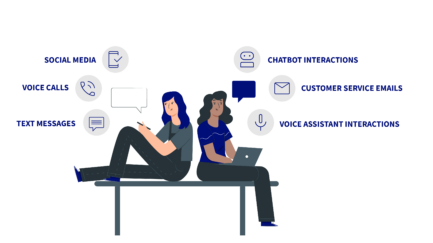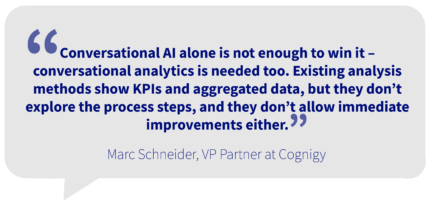During the next four years, conversational AI software services revenue will achieve a 40% CAGR. Why so much interest in this technology? As a provider of contact center conversational AI solutions, we know that beyond agent deflection and real-time agent empowerment, it’s what conversational AI unlocks that’s so powerful. That is, all of the intelligence embedded in the conversational data that your contact center already creates every day.
What is Conversational Data?
Collectively, conversational data is the data collected from natural-language interactions with customers through digital communication channels, including:

Voice calls on their own generate a high volume of valuable data. Let’s say the average agent takes 30 calls a day in a contact center with 50 agents. That’s 1,500 calls’ worth of customer and agent dialogs daily. With AI transcription to convert voice to text, these recordings can become a formidable data pool that can be analyzed for trends, top issues, and other actionable insights. All of this, in addition to the other data available without contact center AI, is in the form of call duration, hold times, average time to answer, and more.
Which brings us to the next point: the data alone is just data.
As Marc Schneider, VP Partner at Cognigy, pointed out during our interview back in 2021, contact centers need more than data or even conversational AI.

The right conversational AI and analytics solution takes conversational data—interaction signals, transcriptions, etc.—and turns them into customer intelligence. It can collect, analyze, and make actionable all that customers are telling you, all of the many signals they’re sending.
Power of Conversational Data and Analytics
This intelligence can pay considerable dividends in terms of operational efficiency, agent productivity, and customer experience. The analysts at Gartner predict that conversational AI will reduce contact center agent labor costs by $80 billion in 2026. There’s little question that part of this cost reduction is the emergence of a better equipped, better informed cadre of contact center agents—under less pressure, thanks to the automations provided by conversational AI.
In addition, many companies now leverage customer data to better read and respond to customer intent, opening the door to personalization at scale in the form of dynamic user personas, GenAI-enabled virtual assistants, and even IoT device integration. According to the 2024 Gartner Emerging Tech Impact report, 75% of customer-facing business applications using conversational AI will integrate so-called “emotion AI” by 2030.
Overall, the companies that invest in unlocking their conversational data enable a variety of high-value use cases for the contact center:
Improve Quality Monitoring
Use conversational analytics to continuously monitor customer interactions. Are your agents adhering to guidelines, using the right scripts, and taking advantage of upsell opportunities? With conversational data and AI, you can score each call and analyze these scores for coaching/training opportunities, performance evaluations, and more—on a per-agent or agent-tier basis.
Analyze Customer Sentiment
Beyond keeping an eye on how your customers feel about their experience, sentiment analysis can help you spot important trends. For example, is there a particular issue, or step in the customer journey around which negative sentiment tends to accumulate? Let the data around customer voice guide you to where action is required.
Analyze Root Cause
Take it a step further by making data-backed arguments for more formal interventions. Conversational data can reveal a product feature or update that’s generating a high volume of cases, or creating a contact center bottleneck. It can reveal strengths and weaknesses among the contact center team that need to be addressed, too.
Enhance Training and Coaching
Replacing an employee can cost up to 100% of their annual salary. Upskilling or reskilling them costs less than 10%. In a cost-sensitive environment like the contact center, conversational data can feed and enhance a more personalized and effective training and coaching program—for both agents and their managers.
Map the Customer Journey
Conversational data can not only reveal how customers interact with contact center touchpoints but help you map this behavior to product experiences and the customer journey overall. This practice can provide critical, data-backed insights into how the contact center, in particular, can better cater to customer needs.
Be More Proactive
The combination of conversational data and AI can lead you to predictions about customer behavior at a scale that humans alone cannot achieve. Conversational data can feed a predictive analytics program that helps contact centers get ahead of customer needs, on a highly personalized basis—something that the modern customer has come to expect.
Deepen Personalization
Powered by conversational data, AI can tailor each interaction with far greater accuracy and on a far grander scale. Imagine an AI-powered chatbot that can adapt to a particular customer profile during the interaction; and then, when needed, personalize the handoff to a live agent who already has the context they need to further personalize the support experience.
Voice Transcriptions and Service Cloud Voice
As it stands today, Salesforce Service Cloud Voice does not natively offer call transcription. But if you already record and transcribe voice calls using another solution (or plan to), you can feed these transcriptions into Service Cloud Voice in real time. Doing so will give you a more holistic, 360-degree view of each customer.

How It Works
First, you’ll need an integration to bridge the gap between your existing contact center system and Service Cloud Voice. b+s Connects is a good example. Using this integration, you can feed voice call transcriptions from Cisco or Webex Contact Center to Service Cloud Voice. With b+s Connects in place, you can:
- Intelligently capture caller interactions in real-time
- Power Salesforce’s Einstein AI / Agentforce with more holistic customer data
- Give agents Next Best Action, knowledge base Recommendations, and Case Wrap-up help
Case Study: Global Insurer Harnesses the Power of Conversational Data
It’s hard to argue with a contact center capable of automating 15 million customer dialogues, while reducing overall average handling time (AHT) by 27%. This is what one global insurer achieved with the help of Bucher + Suter.
The company relies on conversational AI, with a specific focus on voice AI, to power enterprise-scale automation across its contact center experience. By unlocking its conversational data, this insurer has deeply enhanced the quality and value of its service interactions.
Results at a glance
- 24/7 natural language concierge bot for callers serving more than 17 countries
- Increased transparency on the performance of voice automation
- Customer intelligence delivered directly to customer agents
- Improved ease-of-use for voicebots, including hands-on training and optimization
- Faster, more comprehensive training for agents





